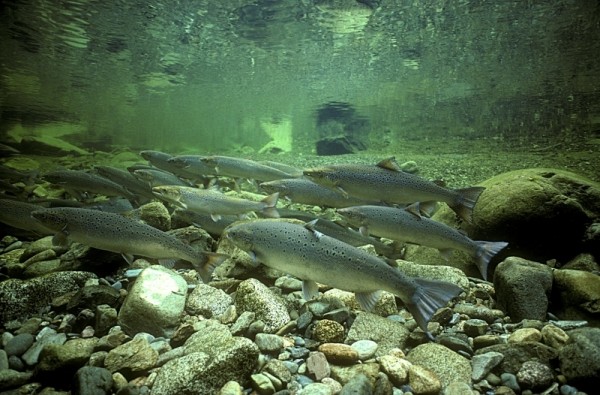Discover intriguing facts about salmon fish! From their remarkable migration to their diverse species, we’ll dive into the fascinating world of these incredible creatures. Join us as we explore the amazing characteristics and behaviors that make salmon fish truly remarkable.
The Fascinating World of Salmon: Uncovering Intriguing Facts
The Fascinating World of Salmon: Uncovering Intriguing Facts
Salmon are not only a popular seafood choice but also fascinating creatures with a remarkable life cycle. From their birth in freshwater rivers to their epic journeys in the ocean and eventual return to their natal streams, salmon exhibit incredible instincts and survival skills.
One intriguing fact about salmon is their ability to navigate across vast ocean distances using their keen sense of smell. They can detect the unique scent of their home river, allowing them to find their way back to spawn after years of living in the open sea. This remarkable behavior has captivated scientists and nature enthusiasts alike, highlighting the astonishing capabilities of these migratory fish.
Another fascinating aspect of salmon is their diverse range of species, each adapted to specific environments and life histories. From the mighty Chinook salmon to the agile Sockeye and the iconic Atlantic salmon, each species possesses unique traits and behaviors that contribute to the rich tapestry of salmon biology.
Furthermore, the role of salmon in the ecosystems they inhabit cannot be understated. As they migrate between freshwater and marine environments, they transport essential nutrients that fuel the food web, benefiting numerous species, including bears, eagles, and even the forests themselves.
In conclusion, the world of salmon is indeed fascinating, filled with incredible facts and natural wonders that continue to inspire curiosity and admiration. Exploring the intricate lives of salmon opens a window to the interconnectedness of nature and the marvels of the natural world.
Most popular facts
Salmon are born in freshwater streams and rivers but migrate to the ocean where they spend most of their lives.
Salmon are born in freshwater streams and rivers but migrate to the ocean where they spend most of their lives.
There are seven different species of salmon, including Atlantic, Chinook, Sockeye, Coho, Pink, Chum, and Steelhead.
Salmon has seven different species, which are Atlantic, Chinook, Sockeye, Coho, Pink, Chum, and Steelhead.
Salmon have an incredible sense of smell, which helps them navigate back to their natal streams to spawn.
Salmon have an incredible sense of smell, which helps them navigate back to their natal streams to spawn.
The largest species of salmon is the Chinook, also known as the king salmon, which can weigh over 100 pounds.
The largest species of salmon is the Chinook, also known as the king salmon, which can weigh over 100 pounds.
Salmon are anadromous fish, meaning they are born in freshwater, migrate to the ocean, and return to freshwater to spawn.
Salmon are anadromous fish, meaning they are born in freshwater, migrate to the ocean, and return to freshwater to spawn.
During their migration back to their spawning grounds, salmon can leap up waterfalls and obstacles with amazing agility.
During their migration back to their spawning grounds, salmon can leap up waterfalls and obstacles with amazing agility.
A female salmon can lay thousands of eggs, which are fertilized by a male salmon, and both parents die soon after spawning.
Female salmon can lay thousands of eggs, which are fertilized by a male salmon, and both parents die soon after spawning.
Salmon play a critical role in the ecosystems they inhabit, serving as a food source for numerous animals, including bears and eagles.
Salmon play a critical role in their ecosystems as a food source for various animals, including bears and eagles.
The color of a salmon’s flesh can range from pink to orange, depending on its diet while living in the ocean.
The color of a salmon’s flesh can range from pink to orange, depending on its diet while living in the ocean.
Farmed salmon now account for over 60% of the world’s salmon production, which has raised environmental and sustainability concerns.
Farmed salmon now account for over 60% of the world’s salmon production, which has raised environmental and sustainability concerns.
In some cultures, salmon is considered a sacred and symbolic animal, often associated with wisdom and determination.
Salmon is considered a sacred and symbolic animal in some cultures, often associated with wisdom and determination.
Salmon is a nutrient-dense fish, rich in omega-3 fatty acids, high-quality protein, and essential vitamins and minerals.
Salmon is a nutrient-dense fish, rich in omega-3 fatty acids, high-quality protein, and essential vitamins and minerals.
The annual salmon runs in places like Alaska and the Pacific Northwest are natural spectacles that attract tourists and wildlife enthusiasts.
The annual salmon runs in places like Alaska and the Pacific Northwest are natural spectacles that attract tourists and wildlife enthusiasts.
Some populations of wild salmon are threatened or endangered due to habitat destruction, overfishing, and other human impacts.
Wild salmon populations are threatened or endangered due to habitat destruction, overfishing, and other human impacts.
Salmon have a remarkable ability to imprint on the scent of their natal stream, allowing them to find their way back years later to spawn.
Salmon have a remarkable ability to imprint on the scent of their natal stream, allowing them to find their way back years later to spawn.
In conclusion, the salmon fish is a fascinating and vital species, offering a wealth of interesting facts that shed light on its remarkable characteristics and behavior. Understanding these aspects not only enriches our knowledge of the natural world but also underscores the importance of preserving and protecting salmon populations for future generations.
